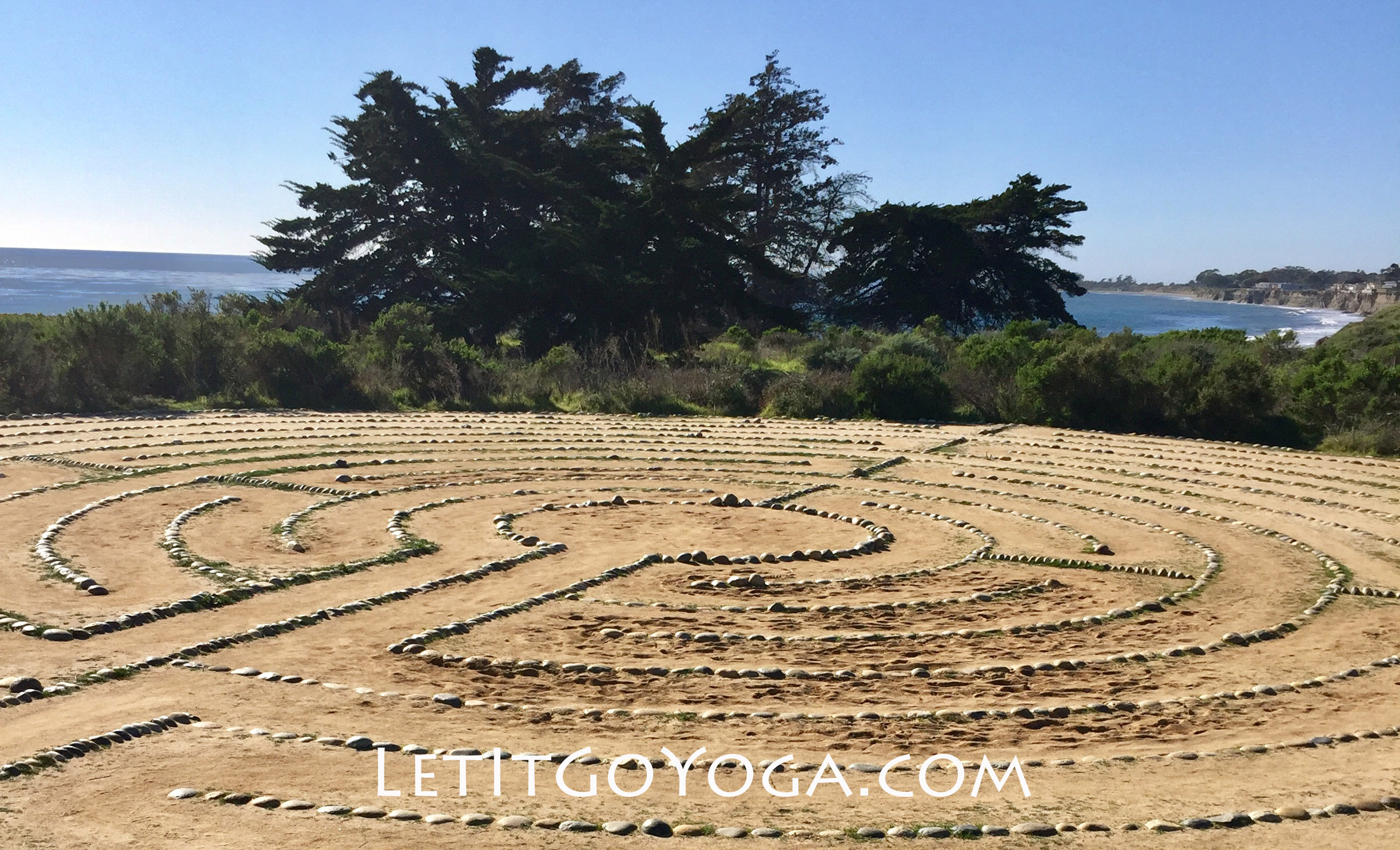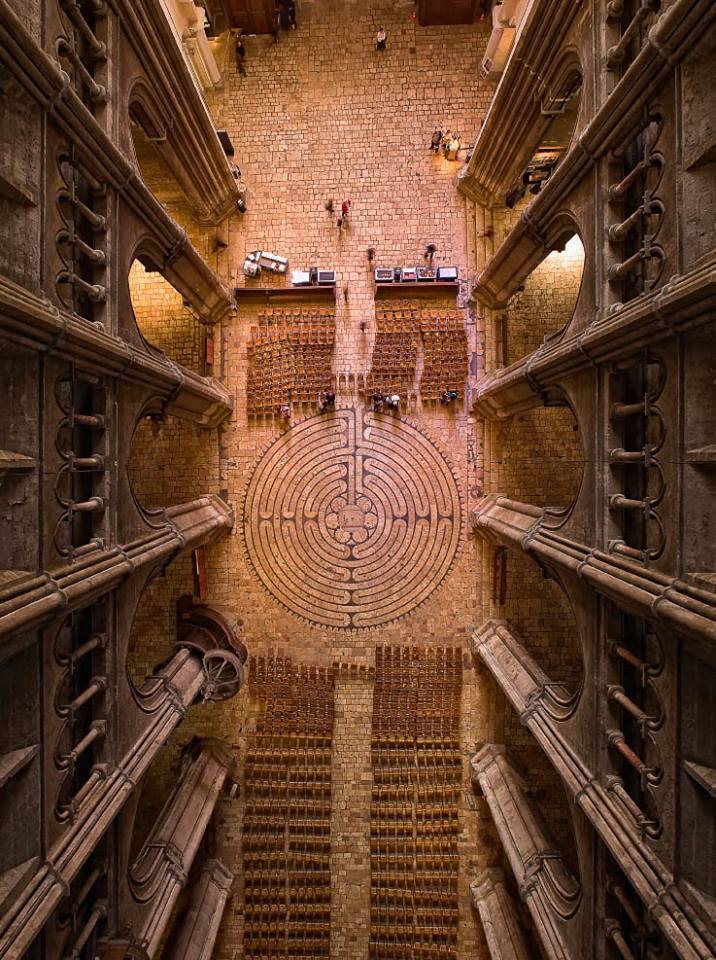Labyrinth images are found in many cultures. We all know (from school) the story from Greek mythology about the labyrinth (Greek: Λαβύρινθος, labýrinthos) at Knossos that the talented Daedalus built for King Minos of Crete to keep the terrifying Minotaur – a creature with a head of a bull and a body of a man – “locked away”, as the labyrinth was so elaborate that the builder himself had hard time getting out of it after finishing his masterpiece. And even though the myth is just a myth and there is no real evidence of the existence of the king himself and of his giant labyrinth, and his half man- half bull son, there are coins found, dating from Middle Bronze Age (1500-1200BC) with the image of the labyrinth on one side and the Minotaur on the other, stamped with Knos or Knosion.
Labyrinth walking is an ancient practice used by many different faiths for contemplation, spiritual centering, and prayer. Many of us also know of The Chartres Cathedral Labyrinth (in France) that was (most likely) built in the early 13th century. Pilgrims turned walking this particular labyrinth into an important part of their pilgrimage. The Chartres Cathedral is now a UNESCO World Heritage site. Nowadays the labyrinth, found inside the cathedral, is usually covered in chairs. (There is information that once a week the chairs are removed and the labyrinth is there for anyone to walk it, and then there is also conflicting information that that is done only once a year – on June 21st). I was lucky enough to attend one of the organ music concerts in that Cathedral some years ago, and do remember feeling a tad sad that I could not see and experience the beauty of the famous labyrinth, it was also a bit strange to sit in a chair placed on top of what represents the deep seeking and a sacred journey inwards. However, eventually I did get to see and walk “that” labyrinth – here in Santa Barbara, as right on our State Street there is a replica of Chartres Labyrinth next to the entrance into Trinity Episcopal Church. Anyone who has attempted to walk it has realized that it takes a shockingly long time to get through the twists and turns that make one focus on one’s balance and breathing. Diana Berryman from TomaandCoe.com says: “It’s a proven fact that when you walk the labyrinth, it calms your nerves. It centers you, literally.”
The Chartres Cathedral Labyrinth
Even more so, because a labyrinth does not present any navigational challenges as it is unicursal – with a single path to the center. And yes, it is a path, a representation of our journey to our own center and back out into the world. Her company – Tom and Coe – in Spain uses labyrinth walking as a team building and trauma healing exercise. They use a large piece of cloth with printed Chartres Cathedral Labyrinth on it, and take it with them to their workshops and retreats.
Thinking about the length of time we have all spent sheltering in place, one could compare that with walking the labyrinth. Or one could try to get to actually walk a labyrinth! Walk and seek the answer, seek the peace and clarity, seek the calm and clearness, as apparently it appears as you near the center of a labyrinth. Or at the end… Walk and seek. And be. Be with the breath and rhythm of your own steps, be with thoughts arising and then leaving your mind, be with the awareness that is so singular and special, focused and yet all inclusive… And right now we have all the reasons to be walking the labyrinth!
Here, in Santa Barbara, we are so lucky! We have not one, but two publicly accessible labyrinths in near proximity – the replica of Chartres Labyrinth at the Trinity Episcopal Church and the Labyrinth Trail on UC Santa Barbara’s Lagoon Island. The efforts to create the UCSB labyrinth were spearheaded and seen through to fruition (even after her retirement) by Carol Geer who was the director of Counseling and Career Services, and executive director of Student Development Services. She has maintained that the need for a place to do a meditative walk grew out of the work with students: “We observed how difficult it was for students, staff, and faculty to find a quiet place on campus to be alone just to think and sort out things. The campus is an exciting place of learning and living, but even positive stimuli can be stressful. The goal was to provide a place and a process for finding the serenity and balance that comes from the interaction of mind, body, and spirit with nature.”
That labyrinth is made out of river rocks and decomposed granite, and built to Americans with Disabilities Act (ADA) specifications, with paths wider than a normal labyrinth, to accommodate wheelchairs.
It speaks to me what Carol Geer said at the labyrinth’s opening ceremony in May, 2011: “I hope that the Labyrinth Trail walkers will carry the peacefulness of their experiences in their memories to sustain them through the presses and stresses of daily life.” She also added that hopefully the labyrinth walk becomes “the most serene and inspirational six-tenths of a mile you’ll ever walk”.
I encourage us all to do exactly that. And if we do not have the access to a ready built labyrinth, let’s turn every walk (well, ok – many a walk) into a meditation and add mindfulness to our experience. Walk to the center. And then back. Walk and Seek.
Written by Indra Strong, Certified Let It Go Yoga teacher.
Let It Go Yoga Introduction Course for $97
Join our Introduction to Let It Go Yoga Course
Enroll Now



Thank you for reminding us that not only Covid threat is uniting us arround the world, but also our common cultural history. I’ve never seen the labyrinth Trail on S.-B.Lagoon Island, but I can only hope it goes ahead yet.